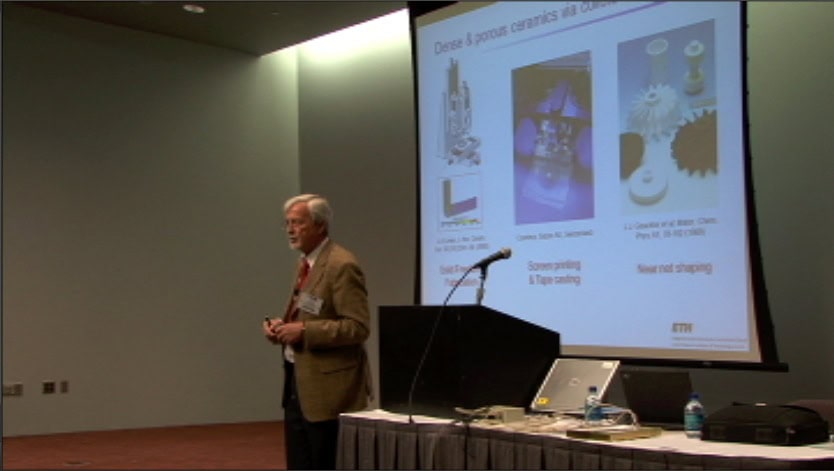
[Image above] Credit: ACerS; YouTube
ETH Zurich professor Ludwig J. Gauckler gave the 2009 Edward Orton Jr. Memorial Lecture at the recently completed ACerS Annual Meeting and MST’09 Conference.
“Tailoring the solid–gas and solid–liquid interfaces of particles by organics offers plenty of possibilities to generate composite materials, via colloid chemistry, with microstructural dimensions spanning several orders of magnitude. New composite materials derived from foams, emulsions and polymer–ceramic combinations are possible and open up new applications. Some concepts to use functionalized interfaces in colloid technology for ceramic processing will be illustrated by a few examples. Manipulating surface potential and Debye length of colloid particles using enzymatic-catalyzed reactions can be used to convert a stable colloid sol to a coagulated stiff gel for the formation of complex-shaped ceramic components. The resulting ceramic components show extremely good mechanical properties and unusually high reliability. Colloid chemistry combined with micropatterning enables hundreds of tiny gas sensors to be integrated in arrays for hitherto unprecedented density. Such microsensors on silicon and silicon nitride micro hot plates can operate as electronic noses to analyze gases.”
Gauckler received his degree in physics from the University of Stuttgart, Germany, and his Ph.D. in materials science in 1976. During that time he worked at the MPI in Stuttgart with G. Petzow and later with T.Y. Tien at the University of Michigan. He was responsible for the nonmetallic inorganic materials development at Alusuisse-Lonza Ltd. Since 1988 he has worked as a professor at ETH Zurich and head of the department of materials science from 1991 to 1993 and from 2008 to the present.

Credit: ACerS; YouTube
CTT Categories
- Electronics
Spotlight Categories
- Member Highlights


